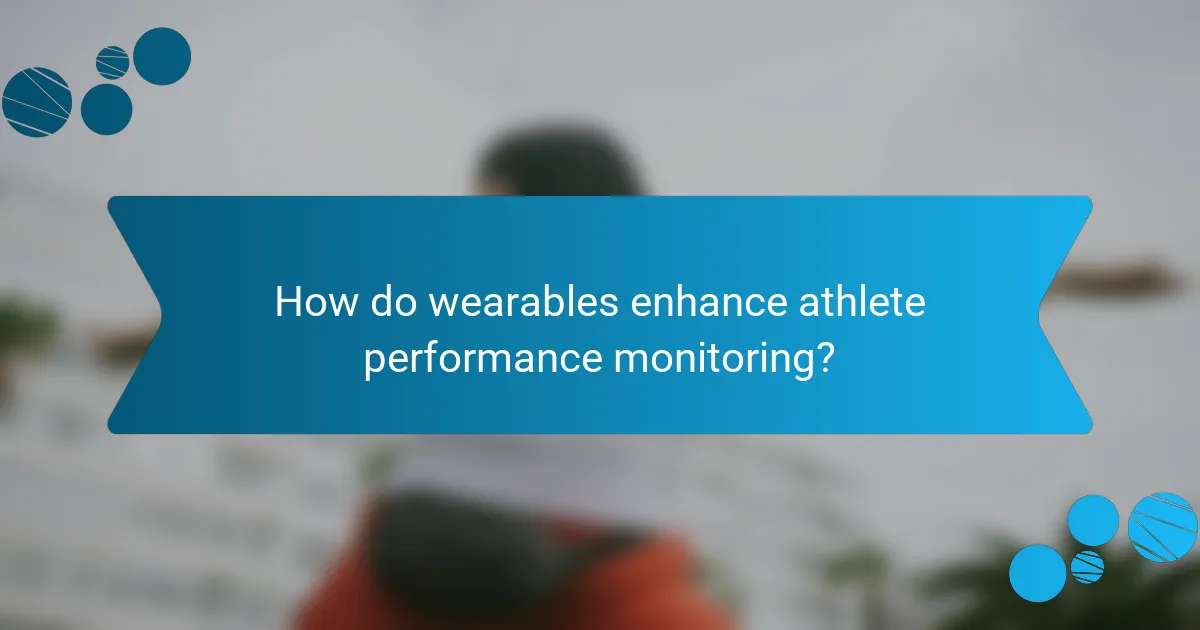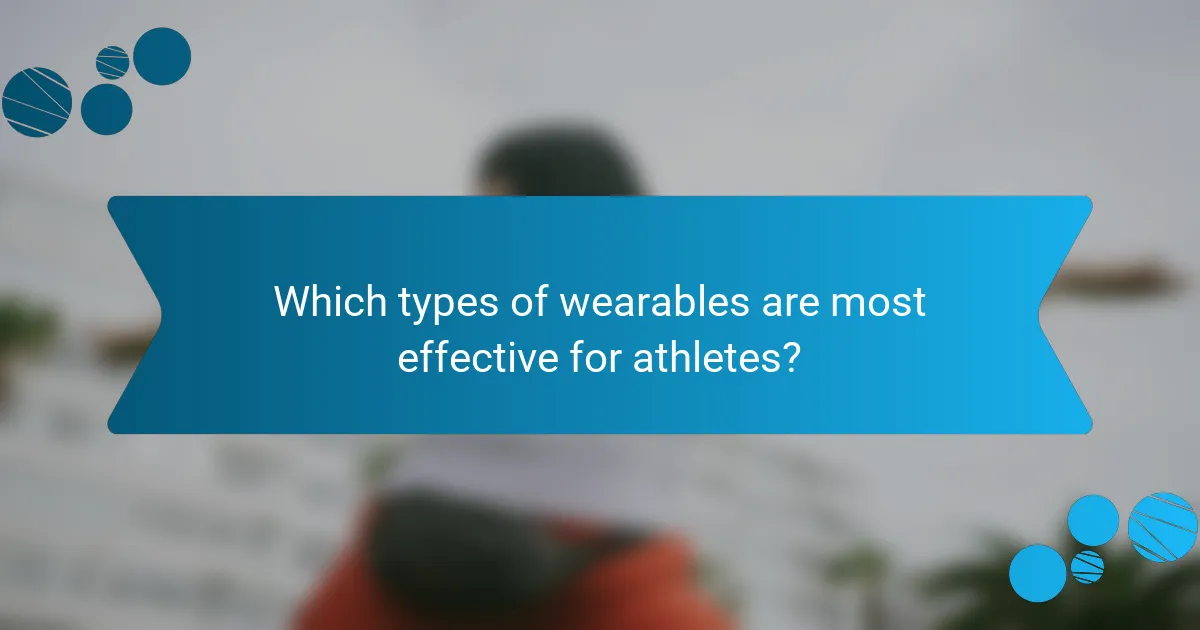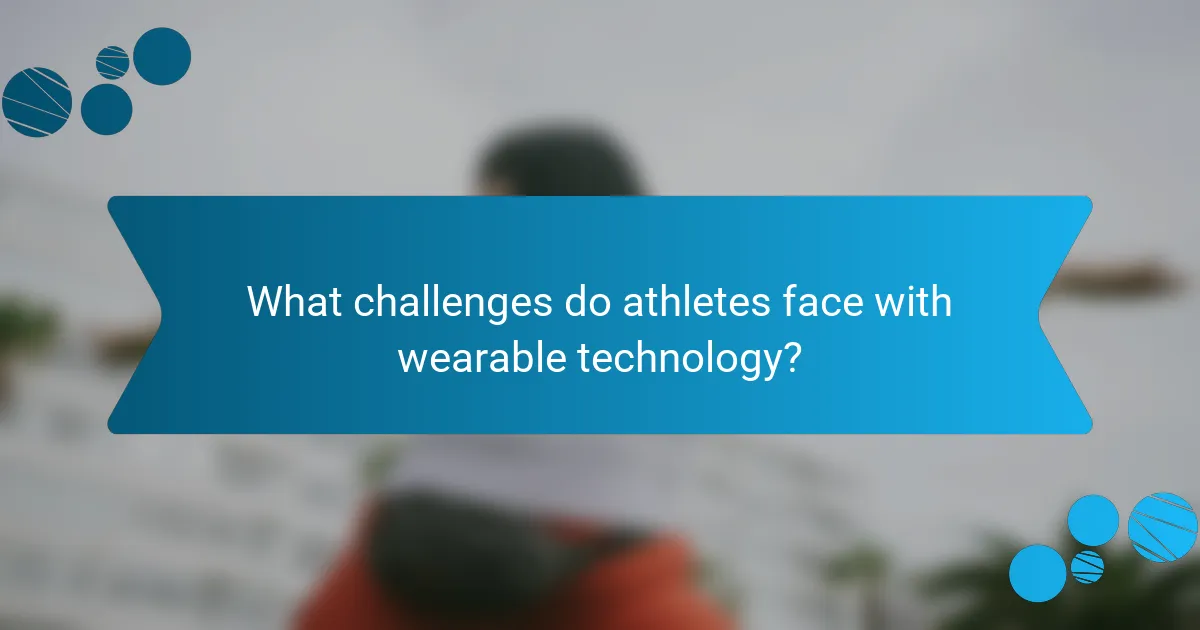Technology integration in athlete training enhances performance and reduces injury risks through real-time data and performance analytics. Wearable devices like heart rate monitors and GPS trackers provide critical metrics for personalised training regimens. Performance analytics software enables coaches to optimise training plans based on individual athlete needs. Recent advancements in sensors and artificial intelligence further refine these strategies, promoting efficient recovery and peak performance.

How do wearables enhance athlete performance monitoring?
Wearables enhance athlete performance monitoring by providing real-time data on various metrics. These devices track heart rate, sleep patterns, and activity levels, enabling personalised training plans. Wearables also facilitate injury prevention through monitoring fatigue and recovery. As a result, athletes can make data-driven decisions to optimise performance.
What data do wearables collect for training analysis?
Wearables collect data such as heart rate, activity levels, sleep patterns, and movement metrics for training analysis. This data helps athletes optimise their performance and recovery. Wearables often measure unique attributes like VO2 max and lactate threshold, providing insights that guide training intensity and strategies. Additionally, some devices track rare attributes like muscle fatigue and hydration levels, offering a comprehensive view of an athlete’s condition.
How do wearables integrate with existing training programs?
Wearables seamlessly integrate with existing training programs by providing real-time data and insights. They enhance athlete performance through metrics like heart rate, sleep quality, and activity levels. This data allows coaches to tailor training regimens, ensuring optimal recovery and performance. Moreover, wearables facilitate remote monitoring, fostering continuous feedback and adjustments to training plans. As a result, athletes can achieve personalised training experiences that adapt to their unique needs and performance goals.

What are the benefits of performance analytics in sports training?
Performance analytics significantly enhances sports training by providing data-driven insights. These insights help in optimising training regimens, improving performance, and reducing injury risks. Wearable technology tracks metrics such as heart rate, movement patterns, and recovery times. As a result, coaches can tailor training plans to individual athlete needs, ensuring more effective development. Furthermore, real-time feedback allows athletes to make immediate adjustments, fostering a culture of continuous improvement.
How can performance analytics improve injury prevention?
Performance analytics significantly enhances injury prevention by providing real-time data on athlete performance and biomechanics. This technology identifies patterns and anomalies, allowing coaches to adjust training loads and techniques proactively. Wearables track metrics such as heart rate, movement efficiency, and muscle strain, enabling early detection of potential injuries. By utilising these insights, teams can implement tailored training programmes that minimise risk while optimising performance.
What role does data visualisation play in athlete performance?
Data visualisation significantly enhances athlete performance by providing clear insights into training metrics. It helps athletes understand their progress and identify areas for improvement. Wearables collect data on various performance attributes, such as heart rate and movement patterns, which visualisation tools then translate into actionable insights. This integration allows athletes to make informed decisions about their training regimens, optimising their performance outcomes. As a result, data visualisation not only facilitates real-time feedback but also fosters a deeper understanding of individual strengths and weaknesses.

Which types of wearables are most effective for athletes?
Wearables such as heart rate monitors, GPS trackers, and smartwatches are most effective for athletes. These devices provide real-time data on performance metrics, enabling athletes to optimise their training. Heart rate monitors track cardiovascular exertion, while GPS trackers measure distance and pace. Smartwatches integrate various functionalities, offering insights into recovery and overall health. The unique attribute of these wearables is their ability to sync with performance analytics platforms, enhancing training strategies. As a result, athletes can make informed decisions to improve their performance and reduce injury risk.
What features differentiate high-end wearables from basic models?
High-end wearables offer advanced features like real-time performance analytics, adaptive training programmes, and superior biometric sensors, distinguishing them from basic models. These devices often integrate with comprehensive ecosystems, providing personalised feedback and insights.
High-end models typically include unique attributes such as longer battery life, advanced materials for durability, and enhanced connectivity options. They also support rare features like ECG monitoring and VO2 max estimation, which are less common in basic wearables.
The integration of artificial intelligence in high-end devices allows for predictive analytics, helping athletes optimise their training regimens effectively. This technology enhances performance tracking and injury prevention, making high-end wearables invaluable for serious athletes.
How do athlete preferences influence wearable technology choices?
Athlete preferences significantly shape wearable technology choices by prioritising functionality, comfort, and data accuracy. Athletes often seek devices that provide real-time performance analytics and injury prevention insights. Customisation options also influence selection, allowing athletes to tailor wearables to their specific training needs. Moreover, brand reputation and peer recommendations play a crucial role in decision-making. As a result, manufacturers must align their products with athlete feedback to enhance adoption and satisfaction.

How does technology integration affect athlete training outcomes?
Technology integration significantly enhances athlete training outcomes by providing real-time data and performance analytics. Wearable devices track metrics like heart rate, distance, and recovery, enabling personalised training regimens. As a result, athletes can optimise their performance and reduce injury risks. Performance analytics also facilitate data-driven decisions, improving training efficiency and effectiveness. This integration fosters a deeper understanding of an athlete’s unique physiological responses, leading to tailored training strategies that maximise results.
What metrics are most impacted by technology integration?
Technology integration significantly impacts metrics such as performance, recovery time, and injury prevention. Wearables provide real-time data, enhancing training efficiency and athlete monitoring.
| Metric | Impact of Technology Integration |
|———————-|—————————————|
| Performance | Improved tracking of speed and endurance |
| Recovery Time | Faster recovery through data-driven insights |
| Injury Prevention | Enhanced monitoring of biomechanical data |
| Training Efficiency | Tailored workouts based on analytics |
| Athlete Engagement | Increased motivation through gamification |
| Data Accuracy | Higher precision in performance metrics |
How can coaches leverage technology for better training results?
Coaches can leverage technology by integrating wearables and performance analytics to enhance training outcomes. Wearable devices track metrics like heart rate, distance, and fatigue levels, providing real-time feedback. Performance analytics software processes this data, offering insights into athlete performance trends and areas for improvement.
For example, wearables can monitor an athlete’s recovery and exertion levels, allowing coaches to tailor training loads effectively. This personalised approach can lead to improved performance and reduced injury risk. Additionally, data visualisation tools help coaches communicate findings clearly, fostering better athlete understanding and engagement.
By utilising these technologies, coaches can create more effective training programmes, ultimately leading to better results on the field or court.

What challenges do athletes face with wearable technology?
Athletes face several challenges with wearable technology, including data accuracy, user comfort, and integration with existing training routines. Data accuracy can be compromised due to environmental factors or device limitations, leading to unreliable performance metrics. User comfort is crucial; wearables can cause distractions or discomfort during training. Integration with training routines often requires athletes to adapt to new technology, which can disrupt established practices. Additionally, data overload may overwhelm athletes, making it difficult to focus on key performance indicators.
How do privacy concerns affect athlete adoption of wearables?
Privacy concerns significantly hinder athlete adoption of wearables. Athletes worry about data security and the potential misuse of personal information. Reports indicate that 60% of athletes hesitate to use wearables due to fears of data breaches. Additionally, the lack of transparency regarding data usage amplifies these concerns. As a result, manufacturers must prioritise privacy features to enhance athlete trust and adoption rates.
What are common technical issues with performance analytics tools?
Common technical issues with performance analytics tools include data synchronisation errors, inaccurate sensor readings, software compatibility problems, user interface challenges, and data privacy concerns. These issues can hinder the effectiveness of wearables in athlete training. For instance, inaccurate readings can mislead performance assessments, while software compatibility issues may prevent seamless integration with other training tools. Addressing these problems is crucial for maximising the benefits of performance analytics in sports training.

How is technology integration evolving in athlete training?
Technology integration in athlete training is rapidly advancing, focusing on wearables and performance analytics. Wearable technology, such as smartwatches and fitness trackers, provides real-time data on heart rate, distance, and calories burned. Performance analytics software analyses this data to optimise training regimens and enhance athlete performance.
Recent innovations include advanced sensors that track biomechanics, offering insights into movement efficiency. These tools help identify injury risks and improve recovery strategies. Moreover, artificial intelligence is increasingly utilised to personalise training programmes, adapting to each athlete’s unique needs and performance metrics.
As a result, technology integration enhances training effectiveness, enabling athletes to reach their peak performance while minimising injury risks. The evolving landscape of athlete training technology promises to redefine standards and methodologies in sports performance.
What innovations are on the horizon for wearables in sports?
Innovations in wearables for sports are focused on enhanced data accuracy and real-time analytics. Future devices will integrate advanced sensors for biometrics, providing deeper insights into athlete performance. Enhanced connectivity with AI will enable personalised training programmes, adapting in real-time based on performance metrics. Additionally, wearables will incorporate augmented reality features, allowing athletes to visualise performance data during training. As a result, these innovations will improve athlete training efficiency and injury prevention.
How do regional differences influence technology adoption in athlete training?
Regional differences significantly influence technology adoption in athlete training by affecting access to resources, cultural attitudes, and infrastructure. For instance, urban areas often have better access to advanced wearables and performance analytics due to higher investment in sports technology. In contrast, rural regions may lag due to limited availability of these tools.
Cultural attitudes also play a role; regions that prioritise sports and fitness are more likely to embrace new technologies. For example, countries with a strong sports culture, like the United States, adopt performance analytics more rapidly compared to regions with less emphasis on athletic training.
Infrastructure impacts the integration of technology as well. Regions with established sports facilities and tech companies are better positioned to implement wearables effectively. As a result, athletes in these areas can leverage data-driven insights for improved performance.
Overall, the interplay of access, culture, and infrastructure shapes how technologies are adopted in athlete training across different regions.
What best practices should athletes follow when using wearables?
Athletes should follow best practices for effective use of wearables to enhance performance. First, they must ensure proper fit and calibration of devices for accurate data collection. Second, regular analysis of metrics like heart rate and sleep patterns helps identify areas for improvement. Third, integrating feedback from wearables into training regimens optimises performance. Lastly, maintaining consistency in usage fosters better long-term results.